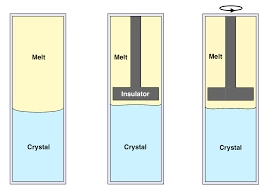In the world of gemstones, the allure of sparkling jewels has fascinated humanity for centuries. Traditionally, these exquisite treasures were mined deep within the Earth’s crust, but recent advancements in technology have led to the emergence of synthetic gemstones, cultivated in controlled laboratory environments.

These lab-grown gems have gained popularity for their ethical sourcing, affordability, and exceptional visual appeal. In this comprehensive guide, we will explore the future technological trends of artificial gem growth, shedding light on the exciting developments and innovations that are shaping the world of gemstone production.
Chapter 1: The Evolution of Artificial Gem Growth
A Historical Perspective
To understand the exciting future of artificial gem growth, it’s essential to take a journey back in time and explore the historical roots of this fascinating field. The concept of creating synthetic gemstones has a rich history that stretches back to the late 19th century when Auguste Verneuil pioneered the flame fusion technique. This remarkable breakthrough laid the foundation for the artificial gem growth we see today.
Auguste Verneuil’s Innovation: In 1886, Auguste Verneuil, a French chemist, introduced the world to the flame fusion technique, often referred to as the Verneuil process. This revolutionary method involved melting powdered minerals in a high-temperature flame and then allowing the molten material to solidify into crystal form. Verneuil’s work marked the birth of synthetic gemstone production and ignited the spark of curiosity among scientists and gem enthusiasts alike.
Early Techniques: In the early days of artificial gem growth, techniques like flame fusion and the Czochralski method played pivotal roles. While these methods were groundbreaking for their time, they did have their limitations. They were primarily used for creating a limited range of gem types, and there was a lack of precise control over the quality of the gems produced.
Chapter 2: Innovations in Crystal Growth
Advanced Growth Methods
The future of artificial gem growth is excitingly intertwined with ongoing advancements in crystal growth techniques. Gemstone enthusiasts, scientists, and researchers are constantly pushing the boundaries to develop new and innovative methods that promise to expand the range of gemstones available and enhance their overall quality.

Hydrothermal Growth: One of the most promising techniques on the horizon is hydrothermal growth. This method replicates the natural conditions in which gemstones form deep within the Earth’s crust. It involves creating gemstones in high-pressure, high-temperature environments, effectively mimicking the forces of nature. Hydrothermal growth offers precise control over gem quality and properties, making it a game-changer in the world of synthetic gem production.
Bridgman Process: Another notable development is the Bridgman process, which places a strong emphasis on precision and quality in crystal growth. By carefully controlling factors like temperature gradients and material composition, this method produces gemstones with exceptional clarity and brilliance. The Bridgman process has garnered attention for its ability to craft gemstones that rival their natural counterparts.

The continuous evolution of crystal growth techniques promises to bring about a future where a wider variety of gemstones, each with enhanced quality and unique characteristics, are readily available. These innovations are not only expanding the horizons of gem enthusiasts but also opening doors to new possibilities in various industries beyond jewelry.
Chapter 3: Customization and Control
Tailoring Gem Properties
As we dive into the future of artificial gem growth, one of the key trends shaping this fascinating field is the focus on customization and control. Gemstone growers are increasingly recognizing the importance of tailoring gem properties to meet specific demands, whether it’s to match individual preferences, industry requirements, or the creative visions of jewelry designers.
Color Control: Among the most significant advancements in customization is the ability to exercise precise control over the color of synthetic gemstones. In the past, gemstone colors were limited to what nature provided. However, with the advent of new technologies and growth techniques, gem growers can now create a stunning spectrum of colors. From the deep blue of a sapphire to the vibrant red of a ruby, the palette of possibilities is virtually endless. This newfound control allows for the creation of gems that perfectly complement jewelry designs and cater to the preferences of discerning customers.
Clarity and Size: Advancements in crystal growth techniques have also expanded the horizons for gemstone size and clarity. The future promises not only larger gemstones but also impeccable clarity. Jewelry designers and collectors alike are excited about the potential to incorporate larger, flawless gemstones into their creations. This trend opens up new avenues for artistic expression and elevates the aesthetic possibilities of gemstone jewelry.
Chapter 4: Applications Beyond Jewelry
Beyond Adornment
The future of artificial gem growth extends well beyond the world of jewelry. These lab-grown gems are finding increasingly diverse and impactful applications across various industries and cutting-edge technologies. The versatility of synthetic gemstones is nothing short of astonishing, and their contributions to advancements in science and technology are gaining recognition.
Laser Technology: One of the most prominent applications lies in the realm of laser technology. Synthetic gemstones, such as Yttrium Aluminum Garnet (YAG), have become indispensable components in the construction of solid-state lasers.

These lasers find use in a multitude of critical applications, including medical devices, industrial cutting and welding, and even military applications. The unique optical properties of synthetic gemstones make them ideal gain media for lasers, ensuring precision and reliability in demanding environments.
Optics and Photonics: The field of optics and photonics relies heavily on the contributions of artificial gemstones. Precision optical components like lenses, prisms, and waveplates often incorporate synthetic gem materials to achieve the desired optical properties. These components play a pivotal role in various scientific instruments, telecommunications systems, and high-tech applications. The exceptional optical quality of synthetic gems enhances the performance of these devices, enabling breakthroughs in research and technology.
In conclusion, the future of artificial gem growth is marked by the twin pillars of customization and diversification. The ability to tailor gem properties to precise specifications, combined with the expanding range of applications beyond jewelry, positions synthetic gemstones as valuable and versatile contributors to multiple industries. As technology continues to advance, we can only anticipate further innovations and the continued rise of synthetic gemstones as essential components of our modern world.
Conclusion
In conclusion, the future of artificial gem growth is indeed an exciting one. It is marked by innovation, precision, and versatility. With the continuous advancements in crystal growth techniques, the ability to tailor gem properties to specific demands, and the expanding range of applications beyond traditional jewelry, lab-grown gems are set to make a substantial impact in various industries.
As technology evolves and scientists and gem enthusiasts push the boundaries of what is possible, we can look forward to even more thrilling developments in the field of artificial gemstone production. These shimmering creations, born from a blend of human ingenuity and natural inspiration, will undoubtedly continue to captivate our imaginations and find their places in our ever-evolving world for many years to come. The future of artificial gem growth shines brightly, promising beauty, utility, and endless possibilities.
FAQs
- 1. Are lab-grown gemstones as valuable as natural ones?
- Lab-grown gemstones can be valuable, but their value is often different from that of natural gemstones. Factors such as rarity and provenance play a significant role in determining the value of natural gemstones, while lab-grown gems are valued for their ethical sourcing and affordability.
- 2. Can synthetic gemstones be distinguished from natural ones?
- In many cases, it can be challenging to distinguish synthetic gemstones from natural ones without specialized equipment. However, gem laboratories and gemologists use various tests and instruments to identify the origin of a gem.
- 3. Are synthetic gemstones considered sustainable?
- Synthetic gemstones are often considered more sustainable than natural ones because they are grown in controlled environments, reducing the environmental impact associated with mining. However, the sustainability of synthetic gem production also depends on factors such as energy sources and waste management.
- 4. What is the most popular synthetic gemstone?
- Sapphire and cubic zirconia are among the most popular synthetic gemstones. Sapphire is often used in jewelry, while cubic zirconia is valued for its affordability and diamond-like appearance.
- 5. Are synthetic gemstones used in high-end jewelry?
- Yes, synthetic gemstones are increasingly used in high-end jewelry. Their quality, customization options, and ethical sourcing make them attractive choices for jewelry designers and collectors.

Frank
Frank graduated from the University of Shanghai for Science and Technology, majoring in optics. As a technical engineer at Crylink Company, he deeply understands crystal materials and laser components.
Related Video(s) with this Article
Related Product(s) with this Article
Related Application(s) with this Article
